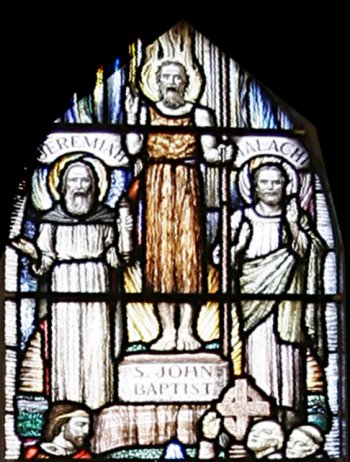
The figures represented in the top panel of the right-hand light are the prophets Jeremiah and Malachi, on either side of John the Baptist. Maynard preached a sermon on these figures on November 21, 1948 as part of his series of sermons introducing the War Memorial window. In that sermon, he concentrated on Jeremiah who is one of the major prophets of the Old Testament. He is represented in the window as an elderly man holding a scroll, presumably of his prophecy concerning the forthcoming destruction of Jerusalem and the exile of her people in Babylon.
Jeremiah lived around the turn of the seventh to the sixth centuries BC. In Maynard's words "He was a statesman, a patriot, and a preacher of righteousness. He was a prophet who was convinced he had a word from the Lord to proclaim to his king and people, in the face of the gathering menace of the growing Babylonian power in Mesopotamia, whose armies were threatening Palestine from the north." Because he lived in times of such threats to his country, Jeremiah is often seen as a pessimist — a prophet of doom — always predicting the worst outcome. But his pessimism about the fate of Jerusalem was balanced by his faith in God, and his vision of a day in which God would make a new covenant with His people in which He would write His law in their hearts. Jeremiah suffered for his faithfulness to his people and to his vision: losing the love, trust and regard of the people for whom he spent himself. He poured out his grief in the book of Lamentations, which has been taken in the Christian tradition as expressive of the anguish of Christ on the Cross.